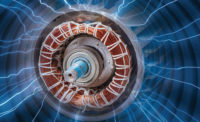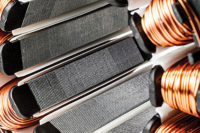Over-tensioning shortens not only the life of V-belts but also that of the sheaves, electric motor, and driven equipment bearings. In extreme cases, it can even bend or break a motor shaft. Unfortunately, premature failures due to the excessive radial load of over-tensioned belts often prompt users to replace drive end ball bearings with roller bearings, rather than to set the belt tension to the correct value. To assure long, reliable operation of all drive system components, follow these procedures when installing, tensioning, and troubleshooting V-belts.
Installing and tensioning V-belt drives
Worried that V-belts may slip and squeal, installers often over-tension them — by a lot. By doing so, they know the belts won’t squeal and they’ll avoid a return trip (and thus, the process of shutting down the drive, removing the covers, loosening motor feet, retensioning the belts, and putting everything back together). This approach can have costly downsides, however, including reduced life of drive components (including catastrophic failures in some cases), unscheduled downtime, and lost production.
In general, the proper way to tension belts for V-belt drives is to set them to an initial over-tension and then readjust the tension after a short operating period. The following 12-step method details the procedures.
Steps for proper installation of V-belts
-
Make certain the motor is turned off and strictly adhere to lockout-tagout (LOTO) and other safety procedures. That includes making sure the belt drive cannot rotate (e.g., such as when an airflow back-draft drives a fan in reverse rotation).
-
After removing the sheave guard, back off the belt tension adjustment, loosen the motor feet, and remove the belt. (Caution: Do not pry the belt off; this could damage the sheave.) Inspect the guard for wear or damage and for evidence of belt contact on the inside. Clean and repair the guard, if necessary, in preparation for reinstallation.
-
Inspect the sheaves and belts for contamination, wear, and damage (e.g., abrasive wear, cracks or fractures in the sheave, and cuts in the belts). If necessary, clean oil, grease, rust, or other contamination from sheave grooves. Measure sheave and belt wear using sheave and belt gauges available from belt and sheave manufacturers or suppliers (Figure 1). Always replace worn belts as a set. Replace sheaves that are worn more than 1/16 in (1.5mm) along one side of the groove. Sheave grooves that are worn to a dished out shape (Figure 2) lose gripping power, causing belts to slip and squeal.
-
Make certain the belts are a matched set from the same manufacturer, and that they were stored in a clean, cool (less than 86ºF /30ºC), and somewhat dry (less than 70% rh) location. Check that both motor (driver) and driven sheaves are rated for the belt cross-section (e.g., B, C, 5V, 8V). Compare belt cross-section profiles with a belt gauge to confirm sizes, particularly 5L and B sections, which have the same height and width.
-
Loosen the motor feet, back off the belt tension adjustment (if not done in Step 2 ), and slip the new belts over the sheaves, inserting them into the grooves without using force. Using pry-bar like devices to insert belts can damage the sheaves as well as the belts.
-
Adjust the motor sheave tension by shifting the motor on its base until the belts are snug.
-
Check the alignment of the motor and driven sheaves with a straightedge, string, or laser alignment device. If using a straightedge or string, make sure they are in contact with the outside faces of both sheaves without a gap between the straightedge or string and the sheave face (Figure 3). Misalignment in excess of 1/10 in per foot (0.5º) angularity can reduce V-belt life.
Caution: Make certain that the sheave rims are equal in thickness. That is, measure the distance from the top (outside diameter) of the sheave groove to the outside of each sheave. If the distances are not equal, repeat the check on the opposite (inboard) side of the sheave. Align using the side that has equal rims of equal thickness.
A laser aligner can also be used to accurately correct sheave misalignment. The laser base unit (transmitter) projects a laser-thin beam of light onto a reflector on the opposite pulley, indicating offset and vertical-angle misalignment. The beam is then reflected back to the base unit, indicating horizontal-angle misalignment. Some aligners use multiple reflectors, providing a precise indication (overlapping return beams coalesce into a single point of light on the transmitter side) when alignment is achieved.
-
Set the belt tension. The correct tension is the lowest tension that keeps a V-belt from slipping under the highest load condition. Too much tension shortens belt, sheave, and bearing life and may even bend or break the shaft. Follow these steps to achieve the proper V-belt tension:
a. Measure the length of the span (LS) between the centerlines of the motor and driven shafts (i.e., the center of the sheaves) and divide by 64 to get the required deflection amount (DA) as shown in Figure 4.
b. Determine the belt deflection force from the applicable table in the manufacturer’s catalog. These tables list minimum, new belt, and retension values for various belt cross-sections (see Table 1 as an example).
c. Place a belt tension tester (Figure 5) on top of the belt at the middle of the span and press down to obtain the required DA. Compare the measured deflection force with the appropriate value (“minimum,” “new belt,” or “retension”) in the belt manufacturer’s table. Adjust and retest belt tension as needed to obtain the correct deflection force.
Example: Determine the setting for a new A section belt that will be used with a small sheave diameter of 4.6 in and has a measured length of span (LS) of 24 in (61 mm).
• Belt deflection amount (DA) = LS/64 or 24/64 = 0.375 in (9.5 mm).
• Table 1 recommended deflection force for the new belt is 5.2 lbs (2.4 kg).
• The tension tester should indicate about 5.2 lbs (2.4 kg) when the top of each belt is depressed 0.375 in (9.5 mm).
Note: The formula for determining belt deflection is “dimensionless,” so the amount of belt deflection when using metric units remains DA = LS/64.
Newer technologies for setting belt tension include sonic tension meters and infrared thermography. Sonic tension meters work on the principle that the correct tension will cause the belt to vibrate and emit a sound at a specific frequency. When the belt is tapped manually, the meter detects the vibration frequency and displays the force associated with that frequency. The tension is then adjusted to achieve the correct force value.
Infrared thermography can also be helpful in adjusting belt tension. Since belts get hotter if they are slipping or too tight, this technology can be used to “tune” the belts to the lowest temperature for the optimum belt tension.
-
Fully tighten the motor base bolts and then recheck the tension; it may change as the bolts are tightened.
-
Replace the belt guard(s) and make certain the motor is secure on its base.
-
Start the motor, observe the drive operation, and listen for unusual noise; if possible, check motor and driven equipment vibration and bearing temperatures.
-
New belts stretch, so belt tension will decrease after the initial seating process. Therefore, readjust the tension after about 24 hours of operation, using the retension deflection force from the belt manufacturer’s tables. Periodically (at least every six to 12 months) check the deflection force and adjust the belt tension if it is less than the minimum or greater than the retension value.
For the A section belt in the example, if the deflection force measures less than the minimum of 3.5 lbs (1.6 kg) with the tension tester after 24 hours of operation, the tension should be reset to the retension value of 4.6 lbs (2.1 kg) per Table 1. Note that this is less than the new belt tension value of 5.2 lbs (2.4 kg).
V-belt drive problems and solutions
Although premature failure of motor drive end ball bearings and breakage of shafts at the drive end bearing shoulder are commonly associated with over-tensioned drive belts, many other faults or undesirable practices can produce similar outcomes. The focus here, however, is limited to V-belt drive problems and solutions associated with over-tensioned belts.
Worn or damaged sheaves. These conditions can lead to belt slippage, rapid belt wear, and possibly vibration. Badly worn sheaves often result in over-tensioning to prevent belt slippage, which in turn can overheat and overload motor and driven equipment bearings. When some sheave grooves are worn more than others, the belts may appear to be mismatched. This may also cause “differential driving,” where not all of the belts carry the same load (stress). To evaluate sheave wear, follow the guidance in Step 3.
Misaligned sheaves. This problem can cause vibration, rapid and uneven wear of V-belt sidewalls, and uneven wear on sheave groove walls, considerably shortening the service life of both belts and sheaves. Misalignment can also lead to separation of the tie-band on banded belts, or apparent mismatching of individual belts in multiple belt drives. V-belt sheave alignment should be within 1/16 in per 12 in (~ 5 mm per m) of drive center distance in any or all horizontal angular, vertical angular, or parallel types of shaft and sheave orientation (Figure 6).
Insufficient belt tension. Other than worn sheave grooves, this is the leading cause of V-belt slippage. Figure 7 illustrates the effects of insufficient tension and over-tension on belt life.
Belt squeal with load often indicates insufficient tension, but belt squeal or “chirping” at startup may be normal. In either case, the best practice is to check belt tension as explained in Step 8.
V-belts don’t always squeal when they are slipping, so the problem sometimes goes undetected. Besides squealing belts, another indication of belt slippage is an accumulation of belt “dust” in the bottom of the belt guard. Belt slippage can also be confirmed by scanning the grooves in the sheave with an infrared thermal imager. (This can be done while the machine is operating if the grooves are visible within the belt guard.) If slippage is occurring, the groove temperature will be at least 40ºF (~20ºC) above ambient.
Regarding belt temperature, there are two factors to consider. The first is that tests have found that V-belt service life is cut in half for every 18°F (10°C) increase in belt temperature. The second factor is that V-belt life decreases more rapidly once the temperature exceeds 140°F (60°C) or 185°F (85°C) for synchronous belts. Belts that run hot will harden and develop cracks from the bottom of the belt upwards.
Note: Do not use “belt dressing” to reduce or eliminate belt squeal. Such compounds treat the symptom not the cause and are usually made from petroleum derivatives that can deteriorate belt materials.
Excessive belt tension. This can be even more detrimental than insufficient tension, affecting not only V-belts but also bearings and shafts (see Figure 7). The best practice is to set belt tension to the deflection force prescribed by the belt manufacturer. Common indicators of excessive belt tension include:
-
Repeated belt breakage
-
Overheated motor and driven equipment bearings
-
Excessive vibration
-
Shaft whip, bent or broken shaft
Mixed brands or mismatched belts. Belts from different manufacturers cannot be matched, and mixed brands will not deliver the service life they should. The same applies to mismatched belts, which are inherently different. Although all belt manufacturers use similar numbering systems, different brands with the same number will have slightly different dimensions and thus should not be mixed in a set. Due to construction differences, they also stretch and ride in sheave grooves differently.
Note: Belt manufacturers say most complaints involving belt matching actually stem from other causes, such as misalignment and worn sheaves. Be sure to consider these factors if mismatched belts are suspected.
Noisy belt drive. When a belt drive is excessively noisy, the belts are often suspected as the cause. To determine if the belts are the source of the noise, spray them with soapy water while the drive is operating. If the noise goes away or decreases, the belts are at least part of the problem. If the same noise remains unchanged after spraying, the problem is probably associated with other drive components.
Conclusion
Although some installers may resist following the above tensioning and troubleshooting procedures for V-belt drives, the payoff for doing so is well worth the effort — longer, more reliable operation of belts and connected equipment, including motors. And that adds up to fewer failures and less unscheduled downtime and lost production.













